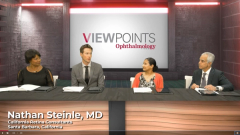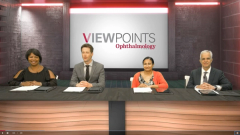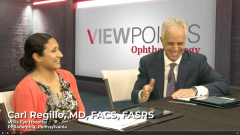
Key Outcomes of Trials of Faricimab in DME
Carl Regillo, MD, FACS, FASRS, and Prethy Rao, MD, MPH, discuss the phase 3 trials of faricimab in the treatment of DME and highlighting the enhanced resolution of intraocular fluid.
Episodes in this series

Nathan Steinle, MD: Faricimab got approved for both neovascular AMD [age-related macular degeneration] and DME [diabetic macular edema] at the same time, which it’s revolutionary from my standpoint. Dr Regillo, talk us through the DME data for the phase 3 trials for YOSEMITE and RHINE.
Carl Regillo, MD, FACS, FASRS: YOSEMITE and RHINE were phase 3 registration studies, identical studies utilizing faricimab for diabetic macular edema, both new and previously treated patients. It was a 3-arm study: 2 faricimab arms, and the control arm as the third arm was aflibercept. Aflibercept was dosed according to the label, with a loading phase followed by a fixed dose every 8 weeks. A very similar faricimab arm had a loading phase every 8 weeks. Then there’s a faricimab variable-dose arm, the personalized treatment interval [PTI], in which the drug was dosed every 4, 8, 12, or 16 weeks, depending on disease activity. It could go up and down, similar to what we do in practice with the treat-and-extend approach. You go up and down on that interval by 4-week intervals.
The study was successful. Both trials met the primary end point, which was noninferiority. It changed BCVA [best-corrected visual acuity] from baseline to 1 year in this 2-year study, and it continued to have essentially equivalent noninferior visual acuity gains over time compared with the control arm. In that PTI arm, this was accomplished with much less dosing of faricimab. In fact, in year 2, it was 3 treatments vs 5 treatments in the fixed-treatment arms. We were able to achieve more or less equivalent visual gains with less drug.
When we looked at the proportion of patients being dosed every 4, 8, 12, and 16 weeks, at 1 and 2 years, we saw a very high percentage of patients who had good visual outcomes after being dosed at 12 and 16 weeks. In fact, we saw very similar percentages as the neovascular AMD study, where 80% of patients were being dosed at the end of the study, at 12 or 16 weeks. About 60% were being dosed as infrequently as every 16 weeks, which is very impressive. That’s not something we’ve been able to achieve with the drugs that preceded it.
Anatomically—this is extra important in the setting of DME—we saw in both trials better drying based on OCT [optical coherence tomography] change in central subfield thickness. Basically, patients were drier faster with faricimab vs aflibercept. Previous studies have definitively shown that DME is correlated to better vision outcomes. Even though we technically didn’t see better vision gains, it’s a better drying drug. The proportion of patients in the faricimab arms that had any DME or intraretinal fluid was lower throughout the entire study. At least it proved that the drug is a better drying drug and, by the nature of the study design, told us that it looks like it’s a longer-acting drug too.
Nathan Steinle, MD: Dr Rao, why would it be a better agent?
Prethy Rao, MD, MPH: The Ang2 affect—fine wine over time—probably plays a role. Dr Regillo brought up a great point about its superior drying effect. In these patients with DME, that’s even more critical because they often don’t lose vision from their DME. It’s more of the hard exudate component and the chronicity of it. It’s harder to get rid of that than the actual CME [cystoid macular edema] effect. If we can dry these patients out faster, maybe we prevent or restore vision or at least stabilize it to prevent all these damaging effects from the exudates.
Transcript edited for clarity
Newsletter
Keep your retina practice on the forefront—subscribe for expert analysis and emerging trends in retinal disease management.





















































